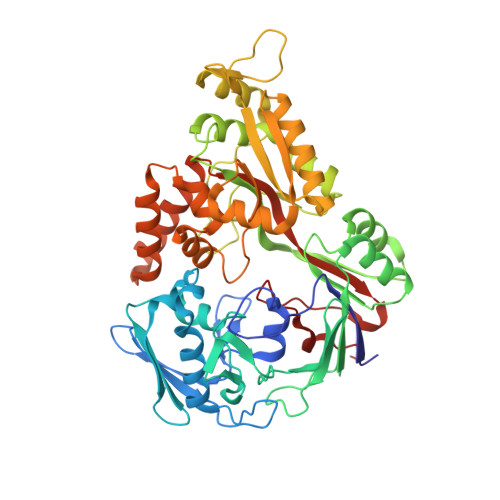Crystallographic and Spectroscopic Evidence for High Affinity Binding of FeEDTA(H(2)O)(-) to the Periplasmic Nickel Transporter NikA
Cherrier, M.V., Martin, L., Cavazza, C., Jacquamet, L., Lemaire, D., Gaillard, J., Fontecilla Camps, J.C.(2005) J Am Chem Soc 127: 10075-10082
- PubMed: 16011372
- DOI: https://doi.org/10.1021/ja0518530
- Primary Citation of Related Structures:
1ZLQ - PubMed Abstract:
Because nickel is both essential and toxic to a great variety of organisms, its detection and transport is highly regulated. In Escherichia coli and other related Gram-negative bacteria, high affinity nickel transport depends on proteins expressed by the nik operon. A central actor of this process is the periplasmic NikA transport protein. A previous structural report has proposed that nickel binds to NikA as a pentahydrate species. However, both stereochemical considerations and X-ray absorption spectroscopic results are incompatible with that interpretation. Here, we report the 1.8 A resolution structure of NikA and show that it binds FeEDTA(H2O)- with very high affinity. In addition, we provide crystallographic evidence that a metal-EDTA complex was also bound to the previously reported NikA structure. Our observations strongly suggest that nickel transport in E. coli requires the binding of this metal ion to a metallophore that bears significant resemblance to EDTA. They also provide a basis for the potential use of NikA in the bioremediation of toxic transition metals and the design of artificial metalloenzymes.
Organizational Affiliation:
Laboratoire de Cristallographie et de Cristallogenèse des Protéines and Laboratoire de Spectroscopie de Masse des Protéines, Institut de Biologie Structurale J.P. Ebel (CEA-CNRS-UJF), 41 rue Jules Horowitz, 38027 Grenoble Cedex 1, France.





















